Honor Magicbook 14 Notebook Review: Where Style Paints a Picasso
by Dr. Ian Cutress on May 15, 2020 9:00 AM EST- Posted in
- Laptops
- AMD
- Notebooks
- Zen
- honor
- Picasso
- MagicBook
- Magicbook 14
- Ryzen 5 3500U
Turbo, Power and Latency
Turbo
As part of our usual test suite, we run a set of code designed to measure the time taken for the processor to ramp up in frequency. Recently both AMD and Intel are promoting features new to their processors about how quickly they can go from an active idle state into a turbo state – where previously we were talking about significant fractions of a second, we are now down to milliseconds or individual frames. Managing how quickly the processor fires up to a turbo frequency is also down to the silicon design, with sufficient frequency domains needing to be initialized up without causing any localised voltage or power issues. Part of this is also down to the OEM implantation of how the system responds to requests for high performance.
For our Honor Magicbook and the Ryzen 5 3500U, we get a base frequency around 1200 MHz, and within 2 milliseconds the system shoots up to a fast 2750 MHz. This is not the final turbo, as it requires another 10 milliseconds going through several frequency stages to finally get to a 3.7 GHz turbo frequency. Overall, from idle, we measured just under 13 milliseconds, which coincides with a single frame at 60 Hz. This is usually the target for user-level responsiveness, so the Magicbook gets a pass here.
Power
As part of my new test suite, we have a CPU power wrapper across several benchmarks to see the power response for a variety of different workloads. First workload up is a heavy AVX-related workload.
The CPU power sits around 1 W at idle, and then goes up to a peak of 13 W, before sitting down to 11 W for the rest of the test. So despite the 3500U being a 15 W processor, Honor has configured the CPU here to only hit 13 W at turbo then 11 W in a sustained test. The sustained part of that turbo isn’t that long, only about 10 seconds or so.
Another AVX test is LINPACK, and here we see the same thing – a turbo up to 13 W and the rest of the test goes to 11 W. The difference here is that when the periodic test gets to around 200 seconds, the maximum power limit tails off into a 9.5 W power limit, suggesting that there are multiple sustained workload power limits on this device. If you can complete the work in 10 seconds, you get 13 W – under 200 seconds gets 11 W, and beyond that gets 9.5 W.
Our 3DPMavx test here does 10 seconds on, 10 seconds off, repeating - allowing the system to recoup some of the power budget for turbo. It sort of works, as we can see spikes of 13 W later on in the test.
This final test is more indicative of a real workload. This is our Photoscan test, which has four segments, some of which are multi-threaded, single threaded, or variable threaded. Here we get more of a 9.5 W through the full test, with the variable threaded part seeing a lot of variation (one core can’t take the whole budget it seems). Nearer the end we are seeing more spiky behaviour as some of the turbo budget gets returned.
Latency
Our latency test is a simple core-to-core ping pong test, to detect any irregularities with the core design. As this is an AMD Picasso processor, the four cores of a single CCX should offer the same latency to each other.
The chip has a 26-27 nanosecond bounce latency.
As for the cache structure, again, this is a typical Zen+ APU result:



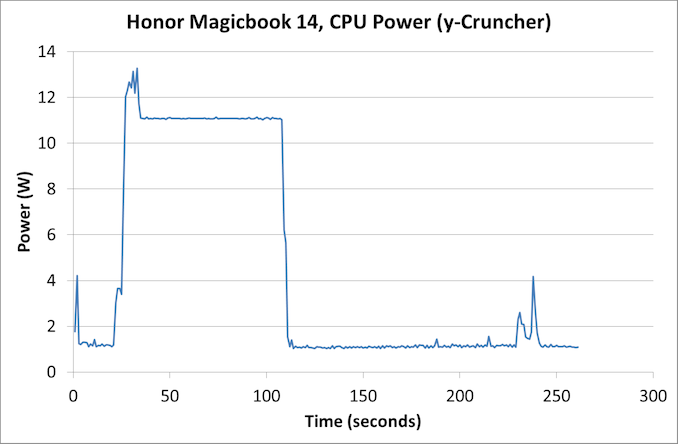
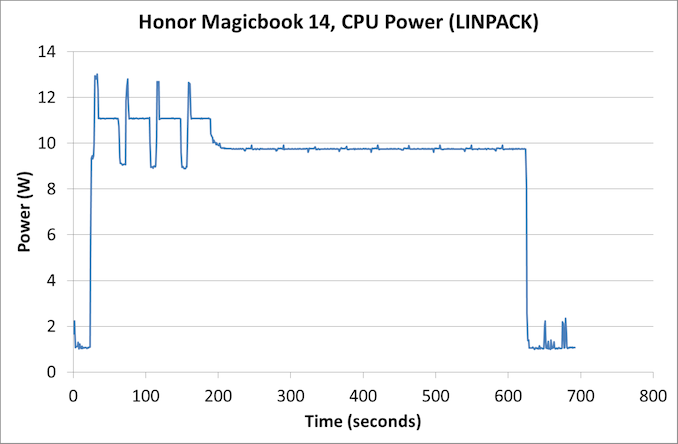
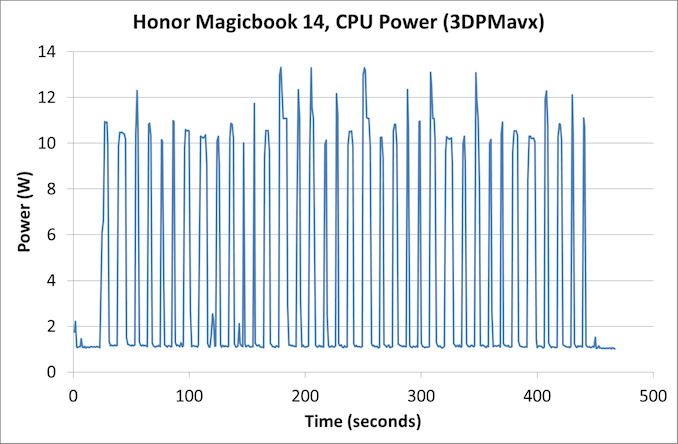
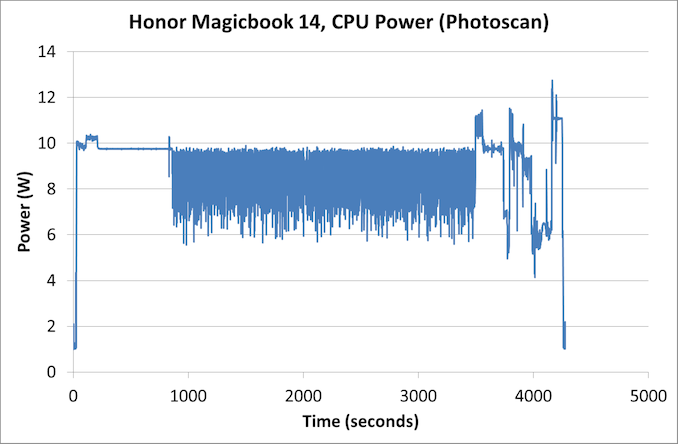

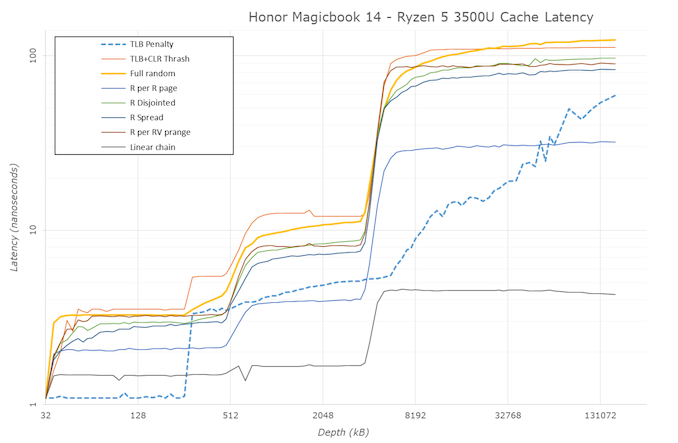








88 Comments
View All Comments
philehidiot - Monday, May 18, 2020 - link
For now, I won't buy a laptop which is all type C. I'm not relying on dingles to be able to read USB sticks people give me and I'm also not a fan of using a laptop atop my lap with a dongle dingle dangling from a wire, asking for a passing person to catch it / exerting excessive stress on the port as the angle of the dangle changes repeatedly. The idea of a standard is that anyone can use it. Having to remember your dongle, or being screwed having lost it, completely negates the advantages of a standard that everyone uses. USB C doesn't need to force itself on everyone by removing USB A ports. It needs to become part of a slow transition determined by necessity / superiority / price. I am not buying a load of new USB sticks for no good reason except someone changed the standard and wants prettier laptops.Spunjji - Monday, May 18, 2020 - link
Personally, I prefer a mix. One or two USB-C / Thunderbolt 3 for multi-role use with the right cables, and a bunch of USB-A for 95% of the things one needs USB for in the first place.ads295 - Friday, May 15, 2020 - link
Just curious, what devices do you use that have you hankering for Type-C ports?nicolaim - Friday, May 15, 2020 - link
A laptop is something most people keep for 3, 5, maybe 7 years, so it should have the ports you'll need down the road rather than obsolete ones that are being phased out.USB-C also optionally includes Thunderbolt, DisplayPort, HDMI, charging, 20 Gbit/s data rate, same connector as USB4, etc., none of which are possible with USB-A.
raywin - Friday, May 15, 2020 - link
couldn't agree more, i'm stuck on a 2013 laptop and I want an upgrade but don't want to lose my ports, only option right now is the VAIO, this is so close to perfection I may just get it anyway.Lord of the Bored - Saturday, May 16, 2020 - link
Key word: optionalI don't want schrodinger's port. I want to look at my port and KNOW what it does, not search for the appropriate 1/8" icon.
yankeeDDL - Saturday, May 16, 2020 - link
Wow. How do you use your laptop? Without the "massive" bezel at the bottom the screen would be even lower than it already is and you'd have to look down even more.And "a bunch of USB A ports"? Thank god for that. I have a Portege with 3 ports and have to travel with a hub. I have two mobile phones, a Logitech dongle nearly permanently plugged in. Wireless headset also need charging, USB memory key and a YubiKey for security. Man, there's never enough USB A ports in a laptop.
sonny73n - Saturday, May 16, 2020 - link
The “massive” bezel underneath is perfect. Sometime I lay down on the sofa and watch YouTube while the laptop still on the desk. Nobody should let you design anything, ever.Lord of the Bored - Tuesday, May 19, 2020 - link
Nobody should let you do PR for a communist nation with a history of human rights abuses, and yet here we are. Not everyone does the job they are most suited for.cfenton - Friday, May 15, 2020 - link
Do you have any numbers for the display's color accuracy? It looks terrible in the example, but it's hard to compare to others without numbers. Is it worse than the Swift 3, for example? It's nice to know that it can be calibrated, but I can't imagine many people looking for a budget laptop have color calibration hardware.